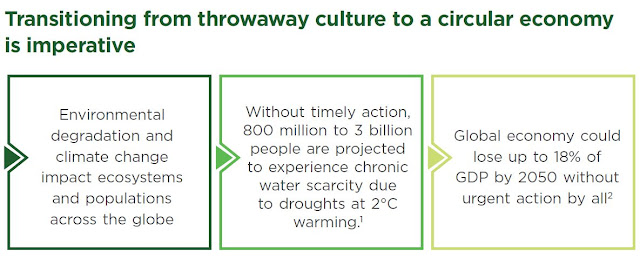Role of Higher Education Institutions towards Climate Change
Climate Change is a reality today and evidences are already being experienced in most parts of the world. The potential threat of climate change is tremendous and can affect the environmental as well as economics of the world. 'Lifestyle for environment' is a movement initiated under Niti Aayog, to promote awareness and introduce Climate Change Action.
Raising the overall awareness levels of the community and collective
action alone has immense potential in creating a lasting impact. One
significant area of deliberations and research is the revival of 'circular economy', wherein 'the
end of one life cycle of the product can mark the beginning of the other
product'.
Lifestyle For Environment (L.I.F.E.)
is an India led global mass movement. The moment identifies contribution by
stakeholders as Pro-Planet-People (P-P-P). India has immense resource of
Traditional Knowledge Systems to learn and adopt from as a cultural continuum.
The Higher Education Institutes can contribute in raising the overall level of
awareness by sensitization programs and implementing environment consciousness
as a part of Institution Culture. LiFE was introduced by Prime Minister
Narendra Modi—at COP26 in Glasgow on 1 November 2021—as a mass movement for
“mindful and deliberate utilization, instead of mindless and destructive
consumption” to protect and preserve the environment.
LiFE and a Sustainable
Development Goals (SDGs)
The
SDGs focused on sustainable cities and communities (SDG 11), responsible production
and consumption (SDG 12), climate change (SDG 13), life on land (SDG 15), and
life under water (SDG 14) emphasize that all individuals ensure that their lifestyles
are in sync with the resources available on the planet.
Further,
research from the New Climate Economy highlights that bold environmental action
could create as many as 65 million jobs by 2030 (SDG 8: Decent Work and Economic
Growth).
The study of the water conservation
through stepwells, recharge wells, rainwater harvesting techniques, protection
of water riparian zones through identification of auspicious sources and their
revering through revival of customary practices are need of the hour. The
Indian attire as a response to climate and local produce is rooted in
environment sensitivity. The food and drinking habits of the people, the mode
of cooking and the inclusions of local flavous as per seasonal produce and diet
systems were harmonious to climatic adaptation.
The ritualistic customs of consuming
only as much as required and keeping the excess for replenishing the system are
practices that are ideal economy models for sustenance. The study of livelihood
patterns, local practices in art and culture.
By making simple changes in
lifestyle the mission of establishing climate change action can be easily
undertaken through collective wisdom and action. A 'peoples movement' that can
change the way 'industry produce' shall be a benchmarking achievement of this
movement. The people led change can
generate policies at local, state, national and global levels.
The Mission LiFE 2023 is launched in the 75th year of India’s independence, a comprehensive and non-exhaustive list of 75 individual LiFE actions across 7 categories is identified such that most actions are:
- Specific and measurable
- Easy to practice by individuals, communities and institutions, with minimal supply-side dependencies
- Non-disruptive to ongoing economic activity, and, in fact, promoting economic activity in the foreseeable future.
The mission of addressing
climate change is being studied for identifying interventions and bringing
about changes in daily life style. The encouragement of research and
development in the area of climate action is being viewed as the emerging area
of study and exploration. The Institutes are setting up environment and climate
change clocks to work towards achievement of climate action to ensure the same
is reversed. The mission of addressing climate change by 2030 is a major
challenge and India is emerging as the global leader in demonstrating the role
of being the world guru in achieving the same.
As an Corporate social initiative AICTE has initiated installation
of the Climate Change Clocks to inculcate the culture in Institutions of Higher
Education as an active repository of change makers.
M.Arch. (Gen.) M.Arts (History).
Reference: LiFE Lifestyle for Environment, Niti Aayog.
Website: https://www.mygov.in/life/
(For any details contact us)
Website: www.tsapmumbai.in
E-mail: tsap@thakureducation.org
Contact: 022-67308001/02
WhatsApp: +91-9833665446









Thnaks for this useful article about Architect
ReplyDeleteHigher education institutions play a vital role in addressing climate change by fostering research, innovation, and educating future leaders. They equip students with the knowledge and skills needed to tackle environmental challenges. For those seeking the best schools in BTM Layout, look for institutions actively engaged in sustainability initiatives and offering relevant programs.
ReplyDelete